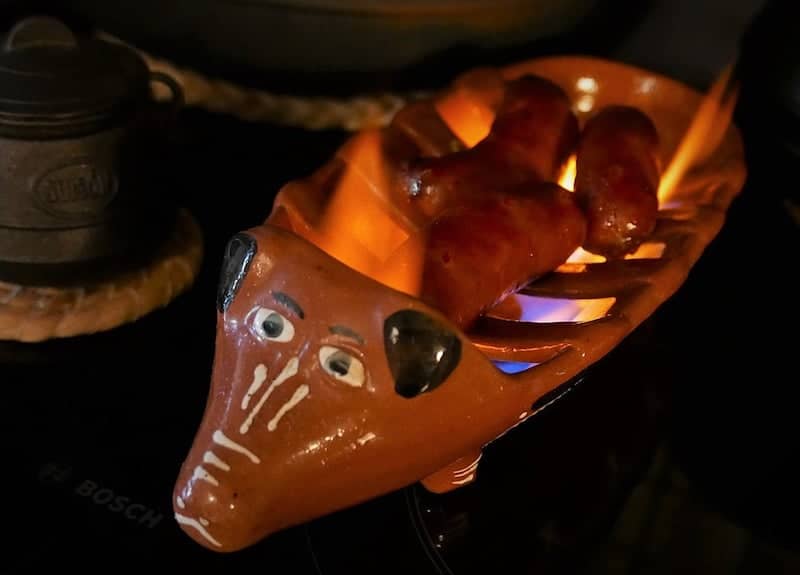Chorizo vs. Chourico (Similarities and Differences Explained)
There are countless varieties of chorizo within the Iberian Peninsula alone, not to mention the entire world. You have your classic Spanish chorizo and Mexican chorizo, and then the Portuguese have their own take on this sausage, known locally as chourico.
When comparing chorizo vs chourico, the two have many similarities. Both are made with pork and have almost identical nutritional values. But, as always, the most notable distinction is in flavoring.
The Portuguese chourico is much lighter with the paprika when it comes to seasoning. Instead of mild or spicy smoked pimento, the aroma comes from garlic peppers and red wine. It’s also almost always smoked, as opposed to the Spanish and Mexican varieties.
| Chorizo | Chouriço | |
|---|---|---|
| Origin | Spain and various Latin American countries | Portugal and areas of Portuguese influence |
| Primary Ingredients | Pork, paprika, garlic, and various spices | Pork, paprika, garlic, and red wine |
| Color | Red due to the significant amount of paprika | Darker red, influenced by red wine |
| Flavor Profile | Smoky and spicy, with variations based on region | Spicy with a hint of sweetness from the wine |
| Texture | Often finely ground | Slightly coarser grind |
| Usage | Eaten raw if cured, or cooked in various dishes | Typically cooked in dishes like stews and grills |
| Varieties | Numerous, based on country and region of production | Fewer varieties compared to chorizo |
| Casing | Natural or synthetic | Typically natural |
| Preparation Differences | Spanish version is dried and cured. Mexican version is often sold fresh and needs to be cooked | Cured and smoked or just cured |

What is Chorizo?
Foodies with an affinity for meat snacks know how hard it is to answer this question.
Basically, chorizo is a type of pork sausage, either fresh or cured, seasoned with a type of pepper (paprika is a firm favorite), a dash of salt, and vinegar.
It originated in the Iberian Peninsula but has since spread across the culinary world like wildfire. As a result, there are many different takes on the recipe, each harboring qualities specific to the culinary practices of a particular region.
In the U.S., we’re most familiar with Spanish and Mexican chorizo, so those are the varieties you usually find your local grocery store.
Spanish chorizo is a cured or rough sausage made from coarsely sliced pork. The intense red color of the link is attributed to the high concentration of paprika in the spice blend. Thus, Spanish chorizo can be on the spicier or sweeter side, depending on the type of paprika.
The pimento is almost always roasted, which imparts a rich, smoky taste to the sausage. Apart from that, various herbs, garlic, and white wine are the typical ingredients.
Spanish chorizo also comes in different shapes and sizes. It can be small or long, heavy or lean, depending on the preparation and mixture. Leaner sausages make for ideal appetizers or tapas, while fattier ones are typically used for cooking.
Tall, thin chorizos are somewhat milder in taste, whereas short chorizos are spicier, though that’s not always the case.
Since Spanish chorizo is usually dried or aged for several weeks, it can be eaten raw and is often served sliced, as part of a charcuterie tray.
The sausage also works great as a spice in grilled dishes such as stews and paella, making it the go-to treat for special occasions.
Mexican chorizo is pretty similar to its Spanish counterpart, with a few notable distinctions.
Typically, the beef is pounded rather than sliced, and the sausage is raw rather than cured.
Also, Mexican chorizo gets its red color from the fiery red pepper as opposed to smoked paprika.
Finally, pork fat and other spices and vinegar are usually added to the meat mixture during the preparation process.
This type of chorizo is sold fresh and therefore has to be cured or cooked before consumption. You can either cook it in its casing or strip it and prepare it like ground beef.
Mexican chorizo is a popular grilling ingredient, but it’s also commonly used in tacos, burritos, chili, burgers, and soups. It works great with even egg-based dishes as a replacement for ground beef.
Both Spanish and Mexican chorizo sausages can be found in most large grocery stores, thanks to the popularity of global cuisine in the United States.
If you can’t find it in your local supermarket, hit the local niche grocery markets, beef markets, and even farmers markets.
Since chorizo is considered a gourmet sausage, you’ll probably come across different handcrafted or artisan varieties.

What is Chourico?
Depending on who you ask, chourico and chorizo are either two names for the same sausage or utterly different meat products. The truth lies somewhere in between since chourico is, in fact, the Portuguese version of the chorizo, with some key differences, mainly with the seasoning.
Portuguese chourico, or chouriço as is the proper term, is typically made with pork and fat. The standard spices include vinegar, paprika, garlic, hot pepper, and salt.
After preparation, the meat mixture is then packed into natural casings made from pig or lamb and slowly dried over smoke. As for seasoning, white pepper, Piri-Piri, cumin, and a dash of cinnamon make the typical blend.
Akin to its Spanish rival, chourico comes in several different varieties of its own.
A common way to prepare chourico is to slice it halfway through and cook it over an alcohol-infused flame in a glazed earthenware dish with a lattice top. The method is called chouriço à bombeiro, and it’s quite a culinary experience.
There’s also the flambé chouriço method, a Portuguese-American restaurant staple. The flambéing is achieved by pouring aguardiente (the Portuguese word for alcoholic beverages) atop the earthenware dish and then firing it up to char the sausage.
Many recipes in Portuguese cuisine include chourico, such as cozido à Portuguesa, a boiled dinner dish, and feijoada, a bean stew with beef and pork.
However, the absolute must-try is the Caldo Verde, a hearty soup made with kale, potatoes, garlic, and chunks or slices of chourico. Not only does adding it make your house smell amazing, but the sausage also provides the right kick to complement the kale.
Sates in the U.S. with a large Portuguese community, such as Rhode Island and southern Massachusetts, have a few signature chourico dishes. Usually, the sausage is combined with littleneck clams and white beans, creating an interesting blend of flavors.
Chorizo vs. Chourico: How are They Similar?
Since there are so many varieties, it’s hard to tell where the similarities end and the differences begin.
However, when stripped to the bone (figuratively, of course), the two sausages are similar. Both chorizo and chourico are fatty sausages made with pork and seasoned with a type of paprika.
They’re low in cholesterol and sugars but high in sodium and saturated fats.
Chorizo vs. Chourico: How are They Different?
Because the meat mixture and nutritional values are pretty much the same, the real difference lies in the seasoning.
Paprika accounts for as much as 20% of the Spanish chorizo spice blend. Typically, it’s either a mild smoked (pimento dulce) paprika or a spicy smoked one (pimento Picante). Sometimes, it’s a mixture of both.
Chouriço, on the other hand, contains less paprika and more garlic and black pepper for flavoring. Because of that, Portuguese sausage is smokier than the Spanish chorizo and a bit darker in color.
Also, unlike Mexican chorizo, chourico can be eaten charcuterie-style, meaning fresh or cold. The preparation includes slow-cooking the sausages in a smokehouse, which gives them a rich color and a smokier taste.
A generous amount of Portuguese red wine is added to round out the aroma. In short, it has a more substantial bite and can hold its own in a variety of dishes.
| Chorizo | Chourico | |
|---|---|---|
| Meat | Pork | Lean Pork |
| Spices | Mild Smoked Pepper, Spicy Smoked Pepper, Chili | White Pepper, Black Pepper, Piri-Piri, Cumin, Cinnamon |
| Preparation | Cured (Mexican chorizo is fresh) | Smoked |
In Summary
Chorizo is a type of pork sausage typically seasoned with paprika. Depending on the geographical region and culinary culture, the flavoring and preparation of chorizo can vary.
Since we’re pretty much talking about different sides of the same coin, it’s not really a question of chorizo vs. chourico. Both are pretty similar types of sausages with their key differences lying in the flavoring.
But, of course, both renditions are a welcomed part of any meat tray.
Interested in how other types of sausages compare to chorizo? Check out my other articles that compare chorizo to:







